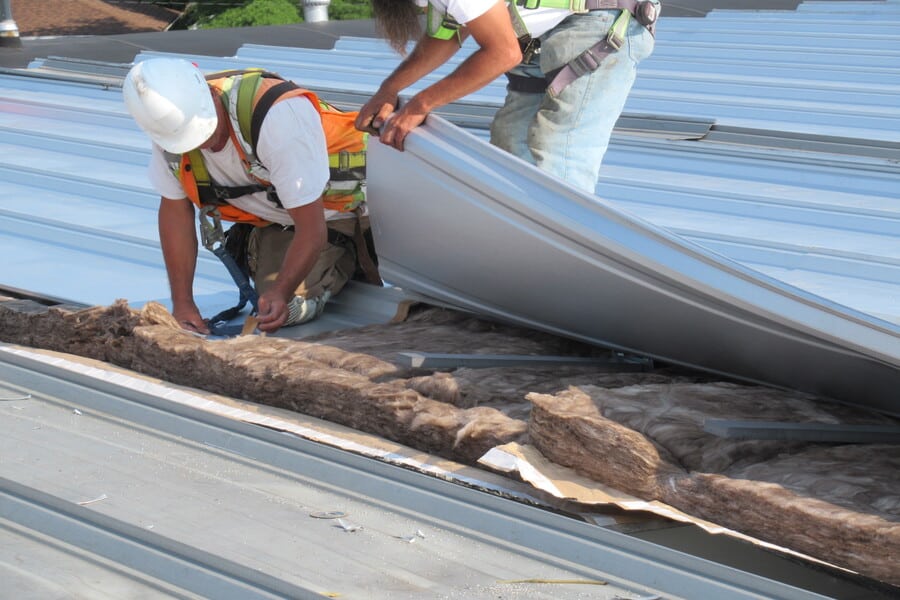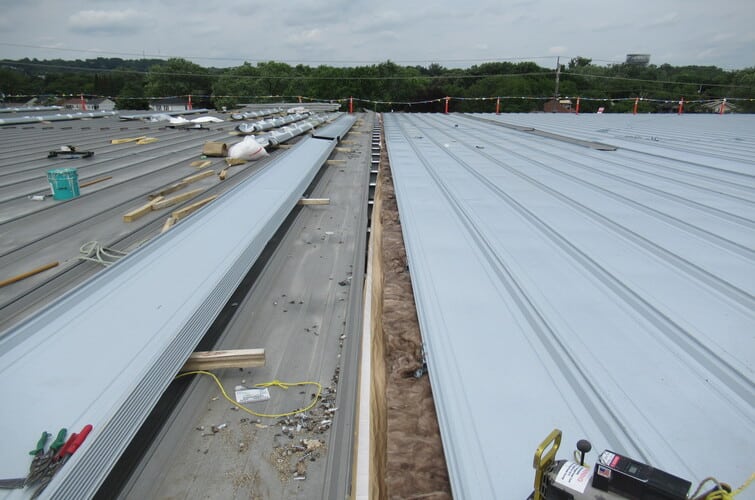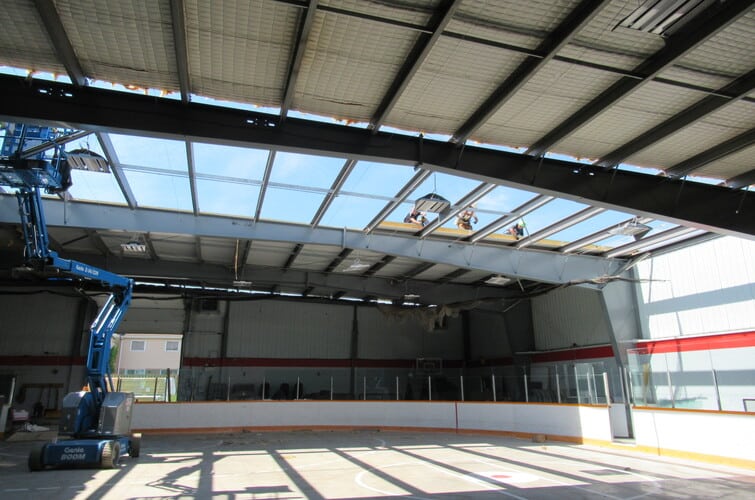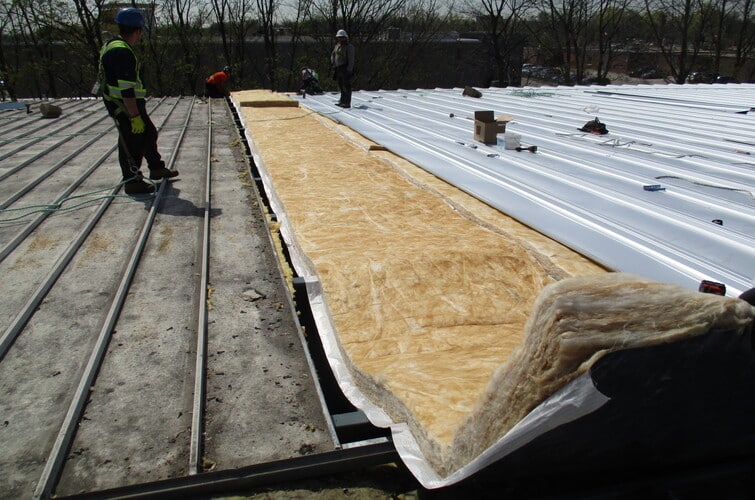500 Hood Road, Suite 320Markham ONL3R 9Z3

There are several advantages to a metal roof system. It is durable and fire-resistant. Metal roofs are relatively lightweight, especially considering their durability. They are also good for reflecting light and heat depending on their colour from the sun which can help with keeping a building cool in summer.
Metal roofs are almost always used on steep slope (pitched) roofs with a pitch greater than 2:12. Metal roofs are more than just a skin of metal on the surface, they can have many other underlying control layers and components. Metal roofs are categorized into two categories; Architectural and Structural metal roofs. The major difference between the two is that metal roof panels in a Structural system are the structural components of the system, whereas, in an Architectural system, panels are non-structural.
Steel and aluminum are most common, as they are cost-effective and durable, but there are several different types of metal roofing, each with advantages and disadvantages.
Copper roofs are very long-lasting. A copper roof replacement is not generally needed, as they can last for hundreds of years. Its lower melting point means less energy is required to produce it.
Copper roofing is also very soft, which makes it quieter than most metal roofs. All metal roofing now uses insulation and methods to minimize noise, though, so the advantage of copper being quieter is now less of a factor. It is easy to work with for excellent results, and it is recyclable.
Because copper metal roofing is soft, it is vulnerable to hail and heavy rain damage. Although denting is not desirable aesthetically, it is preferable to some metals that are harder but will break or puncture under the heavy hail.
Copper roofing costs more than many other metal roofing types. Like all metal roofs, copper will also expand and contract with temperatures, so this needs to be appropriately managed with the right shingle or panel.
Copper roofing is aesthetically pleasing, It weathers to an attractive patina. Because of this and its expense, it tends to be used more just for details.

Aluminum roofs can last a long time. It is excellent for coastal areas, as it is resistant to rust and salt corrosion damage. It is in fact very reactive, but the outer layer of aluminum oxide which forms nearly immediately seals the metal from further corrosion.
Aluminum metal roofs are often painted to enhance their aesthetics.
Aluminum roofs are expensive; they can cost more than steel, but less than copper. As a result, sometimes aluminum roofing that is too thin may be used, to save costs, which can result in damage if used in areas with hail or strong winds. Its strength-to-weight ratio is greater than that of steel, however, so if the right thickness is used, it makes an excellent roofing solution.

There are several steel roof types. Steel is an alloy of iron and other materials, making it a very strong option. It is highly recyclable and is readily available, which helps keep it one of the most cost-effective options. Steel can be used even in areas of hail, heavy snow, and other inclement conditions.
Steel panels and other such options that can be purchased per square foot also help to keep this an affordable roofing material.
Various finishes and coatings are available, to enhance durability and aesthetics. Steel roofing can imitate the look of copper or zinc and reduce metal roofing costs.
Galvanized steels are zinc coated, and often painted or coated with an added topcoat. The zinc coating protects it from corrosion and adds to its longevity.
Galvalume is coated in a combination of zinc and aluminum, lasts longer than galvanized, and is up to four times more effective at resisting corrosion. It is expected to have a lifespan of over 20 years. It has a more uniform appearance.
This was originally used for heavy purposes like bridge construction. The outer layer is intentionally rusted to protect the inner steel. It is used in accent roofs. Using it in roofing requires knowledge of the rusting process and the required regular maintenance.
Stainless steel is more expensive than the other types of steel roofing, but it will not corrode or rust.
Zinc roofing is very long-lasting, and has a very low melting point. Zinc roofs are also resistant to corrosion. It is easily formed and is recyclable.
Aesthetically, it has a chalking effect that some dislike, but a zinc roof can be cleaned and maintained, or can be painted. It is more expensive and does require expert installation. Because it is a softer metal roof type, it can be damaged by hail and winds.
Alloy roofing is strong, durable, and weathers well. Costs depend on the specific alloy.
Tin roofs are not generally used any longer. Many people refer to a metal roof generically as a tin roof.
Standing seam roofing and batten roofing sheets are sold in many sizes that are quicker to install than shingle systems. Both batten and standing seam roofing panels have raised ribs running vertically down the slope, and are the most common patterns for panelled metal roofing.
Standing-seam metal roofs help shed water and snow and do not need much maintenance.
Standing seam roofing has ribs that interlock to shed water and prevent it from leaking through. Various locking systems are available.
Batten roofing has pans that run down along the roof slope, separated by wood battens which are covered with wide cover caps, wider than those on a standing seam metal roof; special parts are required.

Corrugated metal roofing comes in sheets. The corrugated metal panels overlap and are fastened down. A corrugated metal roof is generally not adequate for shedding rain to prevent roof leaks for a house or commercial property.
Regardless of the specific metal roofing materials used, a metal roofing system is durable and lasts a long time, especially as they are very resistant to weather and wear. They are low maintenance and can reduce electricity bills, so can be cost-effective. They are also fire resistant, which is a good safety feature.
1. What are the advantages of metal roof systems? Metal roofs are durable, fire-resistant, lightweight, and energy-efficient. They can reflect light and heat, aiding in cooling.
2. What are the differences between Architectural and Structural metal roofs? In Structural systems, metal panels are structural components, whereas, in Architectural systems, panels are non-structural.
3. What are common materials used in metal roofing? Common materials include steel, aluminum, copper, and zinc.
4. What are the advantages of copper roofing? Copper roofs are long-lasting, easy to work with, and offer aesthetic appeal. However, they can dent and are vulnerable to hail damage.
5. Why is aluminum roofing suitable for coastal areas? Aluminum roofs are resistant to rust and salt corrosion, making them ideal for coastal regions.
6. What makes steel roofing a cost-effective option? Steel is highly recyclable, readily available, and can withstand inclement conditions.
7. What is Galvalume roofing, and why is it advantageous? Galvalume roofing is coated with a combination of zinc and aluminum, making it highly corrosion-resistant and durable.
8. What is Weathering Steel roofing, and what considerations does it require? Weathering Steel roofing intentionally rusts to protect the inner steel. Maintenance and rusting process knowledge are essential.
9. How does stainless steel roofing differ from other steel types? Stainless steel roofing doesn't corrode or rust, but it's more expensive.
10. Are there alternatives to metal roofing materials? Alternatives include zinc, alloy, and tin roofing, each with unique properties and costs.
11. What are Standing Seam and Batten Seam metal roofing systems? Standing Seam systems interlock ribs to shed water, while Batten Seam systems have wood battens and wide cover caps.
12. What are the advantages of Corrugated Metal Roofing? Corrugated metal roofing panels overlap and are fastened down, suitable for various roofing needs.
ABSI Roof Consulting are roof consulting experts, providing professional roof design, inspection, and specification services to building owners and managers.

Naji Hassan, a renowned professional in Building Science and Engineering, brings a wealth of knowledge and experience to his field. Educated at Beirut Arab University and Harvard Business School Online, Hassan has honed his expertise in structural and municipal engineering, building science, and business management. As the President of Accent Building Sciences and an experienced Senior Project Manager, he has made significant strides in building envelope engineering, building condition assessments, and energy retrofit programs. His commitment to innovation and excellence is evident in his approach to large-scale project management and his active participation in industry organizations. Hassan is not only a leader in his field but also a prolific writer and thought leader. He regularly shares his insights and experiences through articles on LinkedIn, which can be found at LinkedIn Articles. Additionally, he maintains a blog where he delves deeper into various aspects of building science, accessible at Accent Building Sciences Blog. Outside of his professional pursuits, Hassan enjoys travel, golf, languages, gardening, and music, reflecting his diverse interests and well-rounded character. Naji Hassan's journey in building science and engineering is not just a career but a testament to his lifelong dedication to learning, teaching, and inspiring others in his field.

500 Hood Road, Suite 320Markham ONL3R 9Z3